A Guide to Successful Pruning: Pruning Deciduous Trees
ID
430-456 (SPES-403P)
EXPERT REVIEWED
Anatomy of a Deciduous Tree
Trees that shed their leaves annually are classified as deciduous. Before doing any pruning, you should know some basics about the anatomy, or supporting framework, of a deciduous tree.
The above-ground part of a tree consists of the trunk, scaffold branches, and lateral branches. The leader is the vertical stem at the top of the trunk. Scaffold branches are primary limbs that form a tree’s canopy. Secondary branches that emerge from scaffold branches are laterals. Growth comes from buds at the tips of branches (terminal buds), or along branch sides (lateral buds).
Water sprouts and suckers are two types of vigorous shoot growth generally considered undesirable. Water sprouts occur along branches. Suckers grow from the trunk or roots.
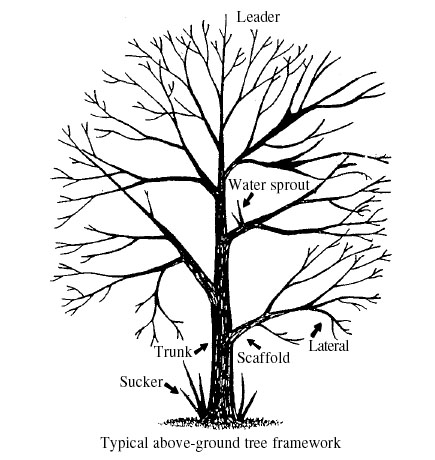
When pruning, picture how the branches are attached to the trunk. The branch collar is the swollen area of trunk tissue that forms around the base of a branch. The branch bark ridge is a line of rough bark running from the branch-trunk crotch into the trunk bark, less prominent on some trees than on others.
What to Prune
Corrective pruning removes damaged wood and eliminates rubbing branches. When pruning dead or diseased branches, make cuts into healthy wood, well below the affected area. Disinfect tools between each cut with products such as “Lysol,” “Listerine,” or rubbing alcohol. Tests have shown that “Pine-Sol” and household bleach are highly corrosive to metal tools and should not be used.
Remove rubbing or poorly placed branches as early as possible. Water sprouts and suckers always interfere with normal growth, so prune them off as they appear.
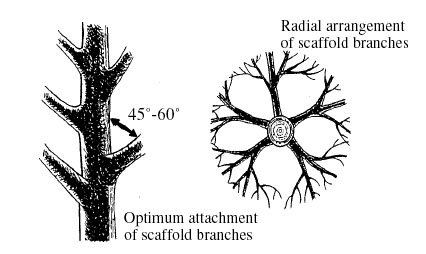
Young tree pruning is for training and prevention to eliminate potential problems before they occur. Select permanent scaffold branches with wide angles of attachment to the trunk. Narrow angles of branch attachment signal a point of future weakness. Be sure branches are evenly spaced (at least 10 inches-12 inches apart) and arranged radially around the trunk. Don’t allow one limb to remain directly above another limb, shading it out. Train trees to single leaders and prevent any laterals from growing higher than the terminal leader, unless multi-stemmed specimens are desired.
When a tree’s leader is lost due to storm damage or disease, replace it by splinting an upper lateral on the highest scaffold to a vertical position. Prune all laterals immediately below the new leader. Use wood or flexible wire splints, removing them after one growing season.
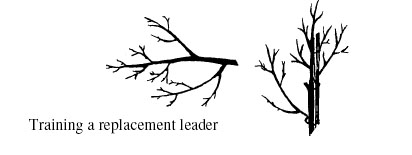
Prune to alter the natural growth habit of trees. For a more open tree, leave terminal buds on all scaffold branches, but shorten or eliminate all laterals. For a taller tree, remove all branches up to a height of 8 feet as soon as the tree has three to four scaffold limbs above this height. For a more compact tree, shorten all scaffold branches by half, prune above outward-facing buds, and allow most laterals to develop.
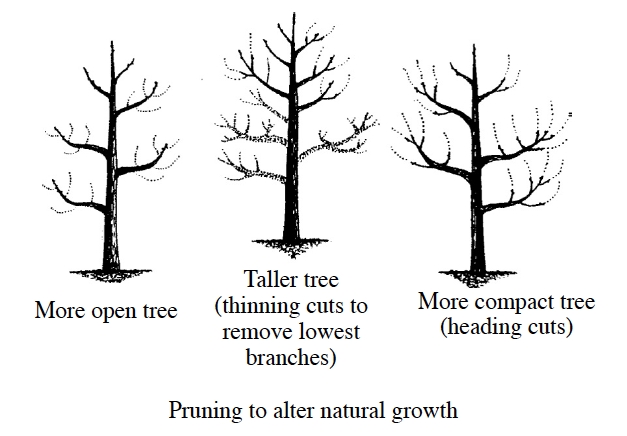
How to Prune
TThere are two basic types of pruning cuts: heading cuts, and thinning cuts. Make heading cuts to reduce the height of a tree by cutting back lateral branches and removing terminal buds. Heading cuts stimulate growth of buds closest to the cut. The direction in which the top remaining lateral bud is pointing will determine the direction of new growth. Don’t use heading cuts (also called topping) on branches over one year old, to avoid stimulating unwanted water sprouts and suckers. Heading or topping also disfigures older trees, compromises tree structural integrity, and exposes large areas of bare wood to disease and insects.
Thinning cuts remove branches to their points of origin or attachment. When you prune a branch back to another branch, or prune a branch from the trunk, you are thinning. Thinning cuts stimulate growth throughout the tree, rather than in single branches, as do heading cuts. “Drop crotching” is a type of thinning cut that reduces a tree’s size while allowing it to retain a natural shape. To drop crotch, select and cut higher branches back to laterals at least one-third the diameter of the limbs being removed. Advantages of thinning include better air circulation, improved sunlight penetration, and less wind resistance.
Make pruning cuts correctly. For heading cuts on young branches, cut 1/4 inch above a lateral bud, sloping down and away from the bud. Avoid cutting too close, or at too steep an angle, or the bud may die. When making thinning cuts to larger branches, cut outside the branch collar at a 45 to 60 degree angle to the branch bark ridge. Leave the branch collar intact to heal the wound quickly and help prevent decay from entering the trunk.
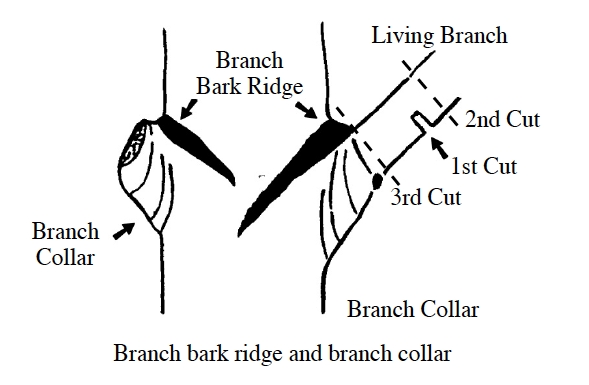
Whenever removing limbs greater than 1 inch in diameter, use the three-cut method to avoid tearing bark. First, about 12 inches from the trunk, cut halfway through the limb from the underside. Second, about 1 inch past the first cut, cut through the limb from the top side. The limb’s weight will cause it to break between the two cuts. Make the third cut outside the branch collar, as described earlier. Use a handsaw to provide greater control.
Don’t coat pruning cuts with tree paint or wound dressing. Coatings won’t prevent decay or promote wound closure, but may actually prevent wonds from healing.
When to Prune
Pruning in different seasons triggers different responses. Late winter or early spring, before bud break, is a good time to prune many species because wounds heal quicker. When pruning flowering trees, take care not to cut off flower buds. Some trees, such as cherry, plum, and crabapple, form buds on old wood. Others, such as crape myrtle, form buds on new wood.
Summer pruning tends to suppress growth of both suckers and foliage. Late summer or early fall pruning causes vigorous new growth, that may not harden off before winter, and could suffer cold damage or even be killed. Whenever unexpected damage from vandalism or bad weather occurs, prune immediately. For more information on when to prune specific tree species, see VCE Publication 430-460, Deciduous Tree Pruning Calendar.
Virginia Cooperative Extension materials are available for public use, reprint, or citation without further permission, provided the use includes credit to the author and to Virginia Cooperative Extension, Virginia Tech, and Virginia State University.
Virginia Cooperative Extension is a partnership of Virginia Tech, Virginia State University, the U.S. Department of Agriculture (USDA), and local governments, and is an equal opportunity employer. For the full non-discrimination statement, please visit ext.vt.edu/accessibility.
Publication Date
May 18, 2022



